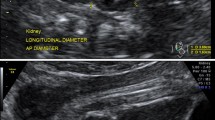Abstract
Purpose
The aim of this study was to determine the morphometric development and location of the kidneys during the fetal period.
Methods
Three hundred and forty-four fetal kidneys, obtained from 172 human fetuses and aged between 9 and 40 weeks, were used in this study. Fetuses were divided into four groups according to the gestational weeks: first trimester, second trimester, third trimester, and full-term gestation. First, the anterior abdominal wall was dissected. Topographic localization of the kidneys in the abdominal cavity was then assessed. The distance between the inferior pole of the kidney and iliac crest was measured. The vertebral levels of the superior and the inferior poles and relations to ribs of the kidneys were determined. The distances between hilum of the kidneys and inferior vena cava, abdominal aorta, and midline of the vertebral column were determined. The dimensions (width, length, and thickness), weight, and volume of kidneys were measured.
Results
The results showed that the distance between the inferior poles of the kidneys and the iliac crest increases with gestational age. The vertebral levels of the superior and inferior poles of the kidneys increased during the fetal period. The level of the left kidney was higher than the level of the right kidney in the fetal period. The posterior surface relations to the ribs showed certain ascendance during gestation, corresponding to vertebral levels. However, fetal kidneys do not reach the same level as adults at full term. The kidneys move farther apart from the midline of the body during the fetal period. The dimensions, weight, and volume of the kidneys increased with gestational age during the fetal period. The ratio between kidney weights and fetal body weights were determined, and we observed that the ratio decreased during the fetal period. There were no sex or laterality differences in any parameter.
Conclusions
The morphometric parameters and the location of the fetal kidneys were determined by the present study. This will also contribute to imaging of fetal kidneys and detection of kidney abnormalities in the intrauterine period. We hope that the present results can provide some useful findings for radiological (ultrasound and MR) studies.



Similar content being viewed by others
References
Cohen HL, Cooper J, Eisenberg P, Mandel FS, Gross BR, Goldman MA, Barzel E, Rawlinson KF (1991) Normal length of fetal kidneys: sonographic study in 397 obstetric patients. Am Roentgen Ray Soc 157:545–548
Crane JP (1993) Anomalies of the renal system. In: Chvernak FA, Isaacson GC, Campbell S (eds) Ultrasound in obstetrics and gynecology. Little, Brown & Co, Boston, p 967
Gray H, Standring S (2005) Gray’s anatomy: the anatomical basis of clinical practice, 39th edn. Elsevier Churchill Livingstone, Edinburgh, p 1271
Konje JC, Abrams KR, Bell SC, Taylor DJ (2002) Determination of gestational age after the 24th week of gestation from fetal kidney length measurements. Ultrasound Obstet Gynecol 19:592–597
Moll KJ, Moll M (1995) Anatomie.14., erweiterte. Germany Kurzlehrbuch zum Gegenstanskatalog, pp 461
Moore KL, Persaud TVN (1998) The developing human, clinically oriented embryology, 6th edn. W.B. Saunders Company, Philadelphia, pp 107, 288–293
Özgüner G, Sulak O (2010) Development of the abdominal aorta and iliac arteries during the fetal period: a morphometric study. Surg Radiol Anat. doi:10.1007/s00276-010-0696-3
Rosati P, Guariglia L (1996) Transvaginal sonographic assessment of the fetal urinary tract in early pregnancy. Ultrasound Obstet Gynecol 7:95–100
Rosati P, Guariglia L (2001) Endovaginal sonographic diagnosis of the fetal urinary tract anomalies in early pregnancy. Arch Gynecol Obstet 265:1–6
Vlajkovic S, Vasovic L, Dakovic-Bjelakovic M, Cukuranovic R (2006) Age-related changes of the human fetal kidney size. Cell Tissues Organs 182:193–200
Witzani L, Bruggr PC, Hörmann M, Kasprian G, Csapone-Balassy C, Prayer D (2005) Normal renal development investigated with MRI. Eur J Radiol 57:294–302
Zalel Y, Lotan D, Achiron R, Mashiach S, Gamzu R (2002) The early development of the fetal kidney—an in utero sonographic evalution between 13 and 22 weeks’ gestation. Prenat Diagn 22:962–965
Acknowledgments
We declare that study design, data collection, data analysis and manuscript preparation of the study were carried out by the authors. No one else has been involved/assisted to this study.
Conflict of interest
We declare that we have no conflict of interest with the organization that sponsored this research.
Author information
Authors and Affiliations
Corresponding author
Rights and permissions
About this article
Cite this article
Sulak, O., Özgüner, G. & Malas, M.A. Size and location of the kidneys during the fetal period. Surg Radiol Anat 33, 381–388 (2011). https://doi.org/10.1007/s00276-010-0749-7
Received:
Accepted:
Published:
Issue Date:
DOI: https://doi.org/10.1007/s00276-010-0749-7




